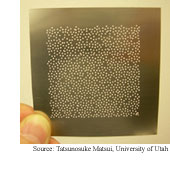|
NEWS
|
Neural light switch
Neurons engineered to include a bacteria gene
are temporarily turned off when hit with yellow light.
Combined with previous work that makes it possible to
stimulate neurons with blue light, the research enables
control of neural activity without drugs. The work could
lead to treatments for epilepsy and other neurological
disorders. (Multiple-Color
Optical Activation, Silencing, and Desynchronization of
Neural Activity, with Single-Spike Temporal Resolution,
PLoS ONE, March 21, 2007)
Superlenses in focus
A pair of superlenses give ordinary optical microscopes
the power to image nanoscale objects previously beyond
reach. The superlenses, made from negative index of refraction
materials, could be used to observe individual biological
molecules in action. In other work, a negative index of
refraction material bends blue-green light backwards,
bringing full-spectrum visible light superlenses and invisibility
cloaks a step closer. (Magnifying
Superlens in the Visible Frequency Range, Science,
March 23, 2007; Far-Field
Optical Hyperlens Magnifying Sub-Diffraction-Limited Objects,
Science, March 23, 2007; Negative
Refraction at Visible Frequencies, Science,
published online March 22, 2007)
Terahertz twofer
 A pair of developments pushes terahertz radiation,
or far-infrared light, closer to practical use for medical
imaging, weapons detection and ultrahigh speed short range
communications. Metal films with semiregular, or quasicrystal,
arrays of holes allow for precise selection of terahertz
frequencies and switching terahertz signals on and off.
And a special type of semiconductor laser emits terahertz
light at close to room temperature. (Transmission
Resonances through Aperiodic Arrays of Subwavelength Apertures,
Nature, March 29, 2007; Bloch
Gain in Quantum Cascade Lasers, Nature Physics,
April 1, 2007)
A pair of developments pushes terahertz radiation,
or far-infrared light, closer to practical use for medical
imaging, weapons detection and ultrahigh speed short range
communications. Metal films with semiregular, or quasicrystal,
arrays of holes allow for precise selection of terahertz
frequencies and switching terahertz signals on and off.
And a special type of semiconductor laser emits terahertz
light at close to room temperature. (Transmission
Resonances through Aperiodic Arrays of Subwavelength Apertures,
Nature, March 29, 2007; Bloch
Gain in Quantum Cascade Lasers, Nature Physics,
April 1, 2007)
Woven logic
Transistors made from crossed textile fibers coated
with electrically-conducting polymers could provide a
route to durable, inexpensive electronic devices woven
into clothing and other cloth. Prototype fabric logic
devices made with the transistors include inverters and
multiplexers, which are basic components of computer chips.
(Towards
Woven Logic from Organic Electronic Fibres, Nature
Materials, published online April 1, 2007)
Nanowire logic in 3D
Prototype electronic devices made from layers
of nanowire transistors show the potential for building
three-dimensional circuitry from nanowires. Layers of
stacked electronics enable many devices per surface area,
but these have been difficult to achieve using today's
chipmaking technologies. (Layer-by-Layer
Assembly of Nanowires for Three-Dimensional, Multifunctional
Electronics, Nano Letters, March 14, 2007)
Forceful chemistry
A chemical reaction triggered by ultrasound opens
a route to producing materials via mechanical force. The
ability to change a polymer's chemical structure in response
to mechanical stress could be used to signal dangerous
structural loads or even to repair damage. (Biasing
Reaction Pathways with Mechanical Force, Nature,
March 22, 2007) |
FEATURES
|
View
from the High Ground: ICL's John Pendry
Physics as machine tool, negative refractive
index, metamaterials, shattered wine glasses, higher capacity
DVDs, scientific backwaters, risk perception and practice,
practice, practice.
|
How
It Works: Quantum computing: qubits
Photons, electrons and atoms, oh my! These particles are
the raw materials for qubits, the basic building blocks
of quantum computers. |
|
 |
News RSS feed 
Blog RSS feed 
Bookshelf RSS feed

New: TRN's
Internet Services
TRN's Jobs Center
|
| |
|
| |
|
| |
"Physics
is to the rest of science what machine tools are
to engineering. A corollary is that science places
power in our hands which can be used for good or
ill. Technology has been abused in this way throughout
the ages from gunpowder to atomic bombs."
- John Pendry, Imperial College London |
|
| |
|
| |
Thanks
to Kevin from
GoldBamboo.com
for technical support |
|

